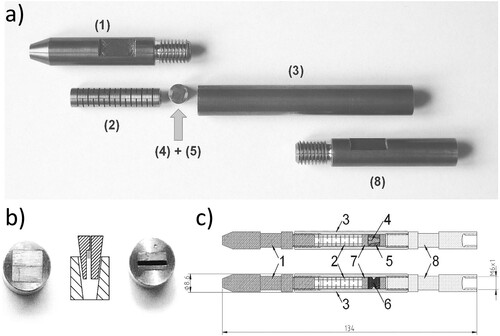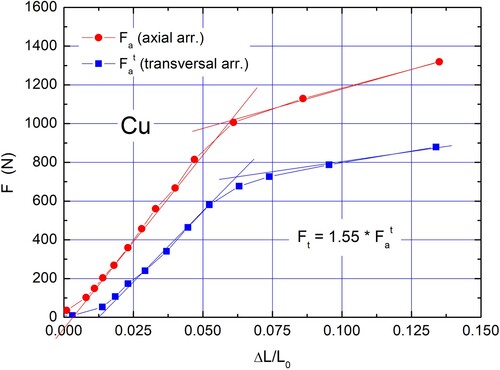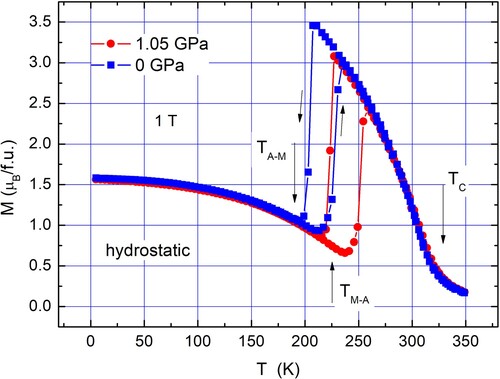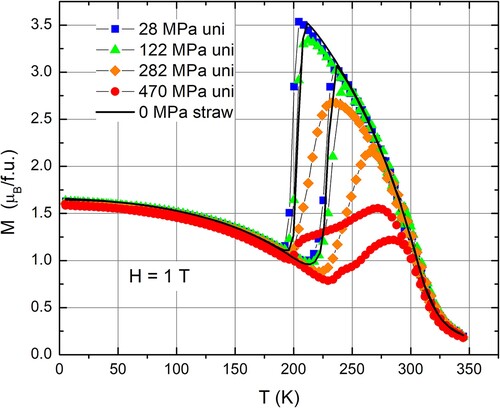 ?Mathematical formulae have been encoded as MathML and are displayed in this HTML version using MathJax in order to improve their display. Uncheck the box to turn MathJax off. This feature requires Javascript. Click on a formula to zoom.
?Mathematical formulae have been encoded as MathML and are displayed in this HTML version using MathJax in order to improve their display. Uncheck the box to turn MathJax off. This feature requires Javascript. Click on a formula to zoom.ABSTRACT
A versatile type of non-magnetic uniaxial pressure cell has been designed for magnetic measurements in SQUID magnetometer. An advanced technology of machining of miniature parts of the cell was used to make new type of an internal squeezer module, where a sample can be compressed by force up to 3 kN in direction perpendicular to external magnetic field. A correct operation of the cell was tested by study of magnetic behaviour of the Heusler off-stoichiometric Ni2MnSn alloy under uniaxial compression. An unexpected significant difference between reversible effects of uniaxial compression on magnetization of the austenite and martensite phases of the alloy is discussed. The uniaxial compression effects are compared with the effects of hydrostatic pressure on a coupling between magnetization and structural transformation of the alloy.
Introduction
In contrast to isotropic effects induced by hydrostatic pressure, uniaxial compression of solids can inspect or assess the intrinsic anisotropy of properties of studied materials. Recently, the uniaxial elastic compression of single crystals of magnetic materials with a huge anisotropy of magnetic interactions along different crystal directions brought qualitatively different view on pressure effects in anisotropic materials in comparison with effects induced by hydrostatic pressure. The huge uniaxial pressure effects have been observed especially in heavy fermions [Citation1], rare-earth manganites [Citation2], intermetallics [Citation3] and high-TC superconducting cuprates [Citation4] using pressure devices with sophisticated methods of the uniaxial stress generation and detection [Citation5,Citation6].
The magnetic shape-memory alloys from the family of the Heusler Ni2MnX (X = Ga, In, Sn, Sb) alloys undergo the structural diffusionless transformation from cubic austenite phase to martensite phase commonly with tetragonal or orthorhombic crystal structure [Citation7,Citation8]. The transformation is realized by a creation of complex structure of crystal twins and finally, it leads to a macroscopic uniaxial elongation of crystals. This is one of the reasons, why we selected the off-stoichiometric Heusler Ni1.88Mn1.6Sn0.52 alloy to test the newly designed uniaxial pressure cell. Moreover, magnetic and structural properties of the selected alloy were studied in detail under ambient and hydrostatic pressure and the results that were described in several works [Citation9–12] offer a possibility to compare effects of uniaxial and hydrostatic pressure.
In this paper, the design, calibration and operation of the uniaxial pressure cell is presented and its use in a study of magnetic properties of the selected alloy is described. The unexpected different behaviour of temperature dependence of magnetization of austenite and martensite phases of the selected alloy induced by uniaxial compression are discussed and compared with the effect of hydrostatic pressure on magnetization of the alloy.
Description of the cell
The non-magnetic uniaxial pressure CuBe cell is designed for the study of solids (single crystals or polycrystals) under uniaxial stress at wide range of magnetic field and temperatures. The uniaxial compression of a sample in the cell can be realized in perpendicular (transversal stress) or parallel (axial stress) directions with respect to the cell axis. In the case of magnetic measurements, it means in the direction perpendicular or parallel to external magnetic field, respectively. The construction of the cell (its dimensions, attachment and materials) was tailored with respect to its use in SQUID magnetometer of Quantum Design Co. The schematic drawings ((c)) show both types of arrangement of the uniaxial non-magnetic pressure cell. In the case of transversal stress, a sample can be carefully inserted into the separate squeezer module that is then put into the cell. In the case of axial stress, a sample is fixed directly on the piston.
Figure 1. The functional parts of the cell: (a) the photo of the CuBe parts described in the text; (b) internal squeezer module; (c) schematic drawings of two types of arrangement of uniaxial pressure cell.

Within the scope of , the photos in (a) show the cell (3) of a tube shape and the supporting (8) and the squeezing (1) screws that compress the tube-spring (2) during pressure experiments. In the case of the axial compression of samples, the spring force is transferred directly on pistons (6), while during the transverse compression, the force is applied on the internal squeezer module that consists of two prisms (4) and their holder (5), see (a) and details in (b). The precise fabrication of rectangular conical orifice in CuBe cylinder (5) ensures right sliding ways for the prisms (4). The spacers (7) reduce a transfer of possible rotation of the tube-springs on the squeezer module or on the piston. Steps of a different height are prepared on the inner surface of prisms (see schematic drawing in (b)) for an easy fixation of oriented single crystals or polycrystalline samples. The steps simultaneously control a protrusion of the prisms (cone 1:8) from the holder (5) with respect to a thickness of a sample. The protrusion of the prisms (4) from the holder (5) can be 1 + 1.5 mm, i.e. a sample can overlap the step on the prism by 0.25 + 0.35 mm. The precise setup of the squeezer module with a sample is a crucial requirement for the operation of the cell. The maximum dimensions of samples used in the cell are 2 × 2 × 0.7 mm3. However, to ensure the lowest inhomogeneity of uniaxial stress, σt = Ft/S, on border of a sample with surface S, a use of samples with height below 0.1 × √S is recommended.
The tube-spring and the squeezer module with rectangular conical orifice represent the main useful innovation of the uniaxial cell in comparison with the cells described in literature [Citation6]. However, an operation of this uniaxial cell strongly depends on a precise fabrication of all the used parts [Citation13] and on a careful calibration of both, the tube-springs and the squeezer module. The force for a squeezing of a sample is generated by the CuBe tube-springs that can produce relatively high axial force Fa by small change of their length ΔL. The value of spring constant k for a determination of force, Fa = k*ΔL, can be tuned by dimensions of the springs. Results of calibration of two annealed CuBe springs L25 (Ø5.5 × Ø3.5 × (14 × 1.5)) mm and L26 (Ø5.5 × Ø3 × (11 × 2)) mm, i.e. outer and inner diameters, spacing width of cutting, are shown in . The tensiometer load cell (Vishay Inc.) was used to calibrate the springs.
Figure 2. Graph of relation between applied force F and change of spring length ΔL recorded during the calibration of the CuBe tube-springs.

In the real experiments, the change of the spring length ΔL can be measured either as a gap between the cell (3) and the squeezing screw (1), or more precisely by use a vernier on the screw (1) surface during its rotation. In the case of the transversal arrangement of the cell, the value of ΔL determines an axial force Fat only. A transfer of axial force Fat into transversal force Ft that acts on a sample in the squeezer module can be described by relations (1) and (2):
(1)
(1)
(2)
(2) where α is the angle of conical prism (tan(α) = 1/8 in this case) and f is coefficient of friction. As it is seen from the equations, the transfer of force Fat into transversal force Ft is very sensitive to the actual friction in the squeezer. Three calibration experiments with actual squeezer module were taken outside of the cell in a press with precise measurement of force by calibrated load cell (Vishay Inc.). The samples of Stenan, Al and Cu were compressed in the squeezer module and almost identical values of coefficient Ct were received (Ct = 1.54; 1.55 and 1.55, resp.), when we compared the values of the yield stress of these materials that were determined by experiments in axial and transversal arrangement of the cell. The result of the calibration experiment with Cu as the sample is presented in . Moreover, the sharp change from the Hook law behaviour to a plastic deformation region shows homogenous load on the sample surface.
Figure 3. Elastic and plastic parts of deformation of the Cu-sample that was compressed in the transversal and the axial arrangements of the cell.

Using the value of Ct and the relation (2), a value of the coefficient of friction between parts of the squeezer module, f = 0.2, was determined. This value of f is commonly used in practice for calculation of friction between any metallic parts and in our case, this value of f verifies a right operation of the cell. The MoS2 micron-powder can be applied on all contact surfaces. It is necessary to emphasize here that the precise fabrication of all parts of the squeezer module, the prisms (4) and the rectangular conical orifice in the holder of prisms (5), is crucial requirement for a right operation of the described cell.
Experimental conditions of magnetic measurements
The polycrystalline Ni1.88Mn1.6Sn0.52 alloy was prepared by electric induction melting in a vacuum with following annealing at temperature 1170 K for 92 h at argon. The details of a characterization of composition, crystal structure and magnetic properties of the alloy are presented in Refs. [Citation10,Citation12]. Magnetic measurements were performed in temperature range from 5 K up to 400 K at magnetic field up to 6T using MPMS-7T (Quantum Design Co.) magnetometer. The referential measurements under hydrostatic pressure were performed in the miniature high pressure CuBe cell [Citation14].
Results and discussion of measurements under uniaxial compression
With decreasing temperature, austenite phase of the Ni1.88Mn1.6Sn0.52 alloy undergoes transition from paramagnetic into ferromagnetic state at the Curie temperature TC and then it goes across the non-diffusive magneto-structural transformation into low temperature martensite phase at temperature TA-M, as can be seen in . In the figure, temperature dependence of magnetization at ambient and under hydrostatic pressure is presented with substantially lower magnetization of martensite phase of the alloy and with pronounced temperature hysteresis of the transformation. All the Mn–Ni and Mn–Mn magnetic interactions are very sensitive to changes of inter-atomic distances in these alloys and hence, a mix of ferromagnetic and antiferromagnetic interactions between Mn-moments in martensite phase of the Mn-rich alloys has been considered and theoretically verified recently [Citation15–17]. The shortest Mn–Mn distances (2.995 and 2.792 Å in austenite and martensite phase of the alloy, resp.) were determined by X-ray diffraction method. This decrease of the Mn–Mn distances during structural transformation was confirmed by the theoretical calculations as an origin of a change of ferromagnetic interaction in austenite into antiferromagnetic interaction between the nearest Mn-atoms [Citation15,Citation16]. A mix of ferromagnetic and antiferromagnetic interactions between Mn-atoms is a reason of the substantially lower magnetization of martensite phase with respect to austenite phase of the alloy, as well.
Figure 4. Temperature dependence of magnetization of the Ni1.88Mn1.6Sn0.52 alloy at ambient (square) and under hydrostatic pressure (circle).

The highest value of used uniaxial compression is limited in each case by a value of yield stress of studied material and hence, high changes of inter-atomic distances could not be expected. Surprisingly, the giant effect of uniaxial compression on magnetization of austenite phase of the alloy has been discovered, see . The ferromagnetic arrangement of magnetic moments in austenite phase was destroyed almost totally by uniaxial stress just below 0.5 GPa, but, the effect of the stress on the TC of austenite was negligible. Despite the giant effect of uniaxial compression on magnetization of austenite phase of the alloy, the temperature dependence of magnetization that was measured at ambient pressure after the uniaxial compression of the alloy (line in ) shows a full reversibility of the giant effect of the uniaxial compression and a full recovery of magnetization of the alloy. On the other hand, the effect of uniaxial compression on saturated magnetization MS of martensite phase of the alloy at 5 K is well comparable with relevant effect of hydrostatic pressure. Values of the pressure parameter of martensite, dlnMS/dP, are only slightly different, dlnMS/dP = −22*10−3 GPa−1 and −34*10−3 GPa−1 in the case of hydrostatic and uniaxial compression, resp. The structural transformation of austenite into martensite is accompanied by a decrease of volume and hence, a significant increase of the transition temperatures TA-M and TM-A has been observed under hydrostatic pressure, dTM-A/dP = + 22.3 K/GPa [Citation12]. Excepting the increase of the transition temperatures, no additional effect of hydrostatic pressure on temperature dependence of magnetization has been detected, see . The changes of the transition temperatures that are induced by uniaxial compression of the alloy are complex. An increase of temperature TM-A has been observed, but, temperature of finish of the transformation from austenite into martensite TA-M seems to be unaffected by uniaxial compression, see . Consequently, significant broadening of the transition was observed under uniaxial compression.
Figure 5. Temperature dependence of magnetization of the Ni1.88Mn1.6Sn0.52 alloy compressed by different uniaxial stresses in direction perpendicular to magnetic field.

The experiments that were performed in the uniaxial pressure cell discovered unambiguously a high sensitivity of austenite phase of the alloy (with cubic crystal structure) to uniaxial compression. Due to the expected small changes of inter-atomic distances, the effect can be ascribed namely to a disruption of the cubic crystal symmetry in austenite that is induced by anisotropic changes of atomic positions under uniaxial compression. A small anisotropic displacement of atoms in martensite phase is probably not able to affect the orthorhombic crystal symmetry significantly and hence, the effect of uniaxial compression on magnetization of martensite is almost negligible. The effect of a partial disruption of the cubic symmetry in austenite on ferromagnetic or antiferromagnetic Mn–Mn interactions has not been studied theoretically up to now, so, further discussion of the experimental results would benefit from detailed calculation of magnetic and structural properties of the Heusler alloys.
Conclusions
The new type of the uniaxial pressure cell was designed and tested successfully by a study of magnetization of the Heusler Ni2MnSn-based alloy under uniaxial compression up to 0.5 GPa. The pronounced and unexpected effect of the uniaxial compression on magnetization of austenite phase of the alloy was discovered. A possible significant role of a disruption of crystal cubic symmetry in austenite in a competition of ferromagnetic and antiferromagnetic Mn–Mn interactions in the alloy was discussed.
Acknowledgement
The authors acknowledge the essential assistance of Dominic Tichý in precise machining of all parts of the designed pressure cell ([email protected]).
Disclosure statement
No potential conflict of interest was reported by the author(s).
Additional information
Funding
References
- Yamamizu T, Endo M, Kimura N, et al. Uniaxial pressure effect on the magnetic phase diagram and femi-surface properties of CeB6. Phys Rev B. 2004;69:014423.
- Beznosov AB, Desnenko VA, Fertman EL, et al. Magnetic and neutron diffraction study of La/3Ba1/3MnO3 perovskite manganite. Phys Rev B. 2003;68:054109.
- Mihalik M, Prokleška J, Kamarád J, et al. NdRhSn: a ferromagnet with an antiferromagnetic precursor. Phys Rev B. 2011;83:104403.
- Takeshita N, Sasagawa T, Sugioto T, et al. Gigantic anisotropic uniaxial pressure effect on superconductivity within the CuO2 plane of La1.64Eu0.2Sr0.16CuO4. J Phys Soc Jpn. 2004;73:1123–1126.
- Arumugam S, Manivannan N, Murugeswari A. Simple uniaxial pressure device for ac-susceptibility measurements suitable for closed cycle refrigerator system. Rev Sci Instrum. 2007;78:063906.
- Kamarád J, Mihálik M, Sechovský V, et al. Miniature uniaxial pressure cells for magnetic measurements. High Press Res. 2008;28:633–636.
- Graf T, Felser C, Parkin SSP. Simple rules for the understanding of Heusler compounds. Prog Solid State Chem. 2011;39:1–50.
- Sutou Y, Imano Y, Koeda N, et al. Magnetic and martensitic transformations of NiMnX(X=In,Sn,Sb) ferromagnetic shape memory alloys. Appl Phys Lett. 2004;85:4358–4360.
- Fichtner T, Kreiner G, Chadov S, et al. Magnetic and transport properties in the Heusler series Ni2−xMn1+xSn affected by chemical disorder. Intermetallics. 2015;57:101–112.
- Kaštil J, Kamarád J, Isnard O, et al. Effect of pressure and high magnetic field on phase transitions and magnetic properties of Ni1.92Mn1.56Sn0.52 and Ni2MnSn Heusler compounds. J Alloys Compd. 2015;650:248–255.
- Chieda Y, Kanomata T, Fukushima K, et al. Magnetic properties of Mn-rich Ni2MnSn Heusler alloys under pressure. J Alloys Compd. 2009;486:51–54.
- Kamarád J, Kaštil J, Friák M, et al. Pressure study of magnetism in off-stoichiometric Ni2MnSn-based alloys. J Magn Magn Mater. 2021;539:168345.
- Tichý D. Precise electro-erosive cutting (unpublished technical specification).
- Kamarád J, Machátová Z, Arnold Z. High pressure cells for magnetic measurements – destruction and functional tests. Rev Sci Instrum. 2004;75:5022–5025.
- Şaşioğlu E, Sandratskii LM, Bruno P. First-principles calculation of the intersublattice exchange interactions and curie temperatures of the full Heusler alloys. Phys Rev B. 2004;70:024427.
- Sokolovskiy VV, Buchelnikov VD, Zagrebin MA, et al. First-principles investigation of chemical and structural disorder in magnetic Ni2Mn1+xSn1−x Heusler alloys. Phys Rev B. 2012;86:134418.
- Friák M, Mazalová M, Turek I, et al. An ab initio study of pressure-induced changes of magnetism in austenitic stoichiometric Ni2MnSn. Materials. 2021;14:523.
